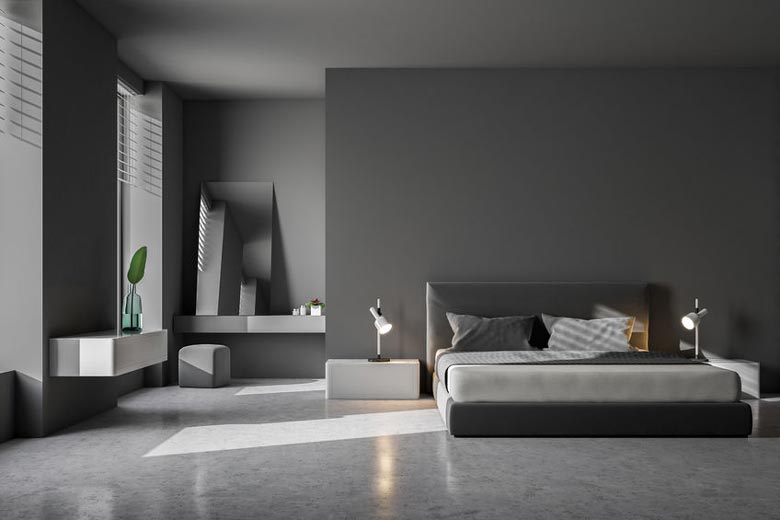Studs are wooden framing designed to hold the structure in place. Most often, you can find it in walls made from drywall or similar materials. But concrete walls seem to be different. Do they have studs in place, or are they unnecessary in a concrete house?
Concrete houses don’t have studs. Studs provide support to materials and hold a structure in place. However, concrete walls are hefty and strong. As a result, the concrete walls in the house do not need the added support offered by studs.
Keep reading to learn more about concrete houses and the structures used to support them. Many different materials are used as studs around the world, but regardless of what you choose, you should know about the advantages and disadvantages of using studs.

Table of Contents
Why Concrete Houses Don’t Have Studs
In most homes, you can find studs placed underneath drywall to hold the walls in place. However, concrete houses do not rely on studs to remain upright.
Concrete houses don’t have studs because studs need to bend and bow to support the live weight of the house. Concrete does not hold up well when it moves or shifts. It will crack and crumble under these conditions, weakening the structure of the house.
While studs are not used to support concrete houses, you can still find studs installed inside concrete homes. These studs are usually there to hold a layer of drywall or insulation in place. Concrete is a very poor insulator on its own—additional insulation is required to boost energy efficiency.
Even in that case, it’s rare to find studs on concrete walls, even when they are not providing structural support to the concrete itself. Studs tend to shift and move in a way that could damage concrete, making them unfavorable.
Concrete walls instead may be left plain, in a modern and stylish aesthetic. Wood or drywall panels, as well as paint, can be easily layered into a concrete wall to alter your home’s aesthetic. All of these materials can be screwed directly to the concrete wall itself and do not require studs to hold them in place.
What Types of Walls Use Studs?
Concrete houses don’t use studs, but there’s a reason why so many other types of constructions rely on them.
Studs are used on interior drywall walls and exterior wooden sheathing on walls. You will usually find studs behind these types of walls, with headers and footers on the top, bottom, or sides. The studs are connected to these pieces to give the structure added strength.
Drywall is hung over a wooden structure that lays underneath, and it usually consists of wooden studs. Drywall is placed against the studs and then nailed or screwed in place. These studs and wooden structures are integral in supporting drywalls.
You will also find studs in place around doors and windows in most houses. Studs are commonly used to hold windows, doors, and surrounding structures in place. They can also serve as a base for electrical outlets and boxes.
You may even find studs in areas near doors and windows in concrete houses; however, these studs are not supporting the walls, only the windows or doors.
What Types of Houses Don’t Have Studs?
Studs are found in homes across the globe to hold up walls and keep structures in place. You already know that concrete dwellings don’t require studs, but are there any other types of houses that can do without them?
Brick, stone, and poured concrete houses don’t have studs. Houses made from these materials do not require the structural support of studs to hold walls in place. Typically, older homes were built from these materials and don’t have studs.
Homes built without studs typically rely on external solid walls to hold everything in place. For example, in a house made of stone, adding wooden studs is not needed to hold up structures unless you wish to add additional insulation inside.
At the same time, adobes, yurts, and sod houses also likely won’t contain studs. They are simply not needed. Another less common variety of homes that does not use studs is igloos. Needless to say, igloos are unlikely to be a viable housing option in most climates.
What Are the Advantages to Not Using Studs in a House?
There are numerous benefits to using concrete as a building material. Concrete is durable, long-lasting, and versatile. However, some of the advantages of using concrete lie in the pieces that are not used. Are there any benefits in removing studs from the picture?
The advantage to not using studs in a house is the added protection against infestations like termites. In warmer climates, termites can destroy wooden structures.
For this reason, it’s not uncommon to see houses built out of concrete or similar materials in these climates. Having to deal with a termite infestation isn’t just bothersome, but can put the structural integrity of the house at risk.
Wood is also prone to catching mold in humid areas. By using a concrete wall, you completely bypass this issue.
Another advantage to not using wooden studs in a house is durability. Wooden studs will not last as long as concrete structures without maintenance, repairs, and replacements. As a result, you can save on maintenance when your home is made of concrete rather than wooden studs.
Building with concrete can be more expensive than simply mounting drywalls. But if your house is exposed to the elements, then concrete might end up saving you money in the long run.
Why Are Metal Studs Not Used in Homes?
Wooden studs are the most common kind of stud that you will find. But timber is not the only material when building with studs. You will often find metal studs in a variety of structures, however, you’re not likely to find them inside a home.
Metal studs are not used in homes because they offer little insulation. Metal studs are smaller in size and don’t have high heat resistance. This means heat can easily pass through metal studs. This increases the energy needed to heat or cool a house, resulting in higher utility bills.
Metal studs are often cheaper than wooden studs. They are also very durable and long-lasting. However, the poor insulation of metal studs makes them impractical for use in homes. Insulation is often a priority for homeowners, and metal studs simply aren’t good enough.
While you could save a considerable amount of money by opting for metal studs over wooden studs during construction, you could end up spending more money in energy expenses. Meanwhile, the superior insulation of wooden studs will lead to reduced heating and cooling expenses.
Metal studs are more commonly found in large structures, sheds, and other buildings that aren’t designed for people to live in. Since these spaces will not be heated or cooled, energy efficiency and insulation will not be prioritized.
Final Thoughts
Concrete houses don’t have studs because they don’t need the additional support of studs to remain in place. Studs are designed to shift and move slightly as weight loads change, but this feature does not suit concrete. These movements could cause cracks or wear in concrete structures.
Concrete houses are strong, durable, and resilient. Another benefit of building concrete houses is added protection against pests. Insects like termites won’t cause damage to concrete as they do to wood. This makes concrete homes ideal for warm climates where infestations are common.




